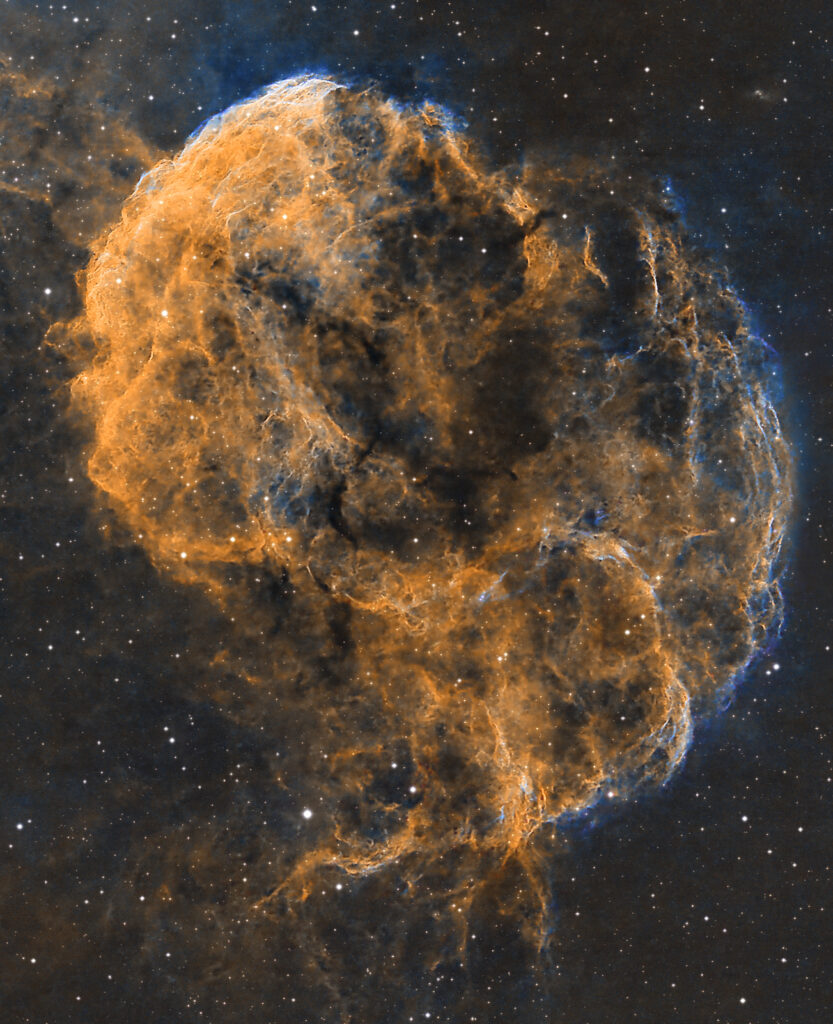The SNR IC 443 is located in the galactic anticenter direction, close to the galactic plane. Many objects lie in the same region of sky: the HII region S249, several young stars, and an older SNR (G189.6+3.3).

Image obtained from the Anunaki Observatory in Ha/S[II]/O[III] filters. In total there are approximately 20 hours of exposure, processed completely in PixInsight.
The remnant is evolving in a rich and complex environment, which strongly affects its morphology. Multi-wavelength observations show the presence of sharp density gradients and different cloud geometries in the surroundings of IC 443. Massive stars are known to be short lived (roughly 30 million years), ending their life when they are still embedded within the progenitor cloud. The more massive stars (O-type) probably clear the circum-stellar environment by powerful stellar winds or photoionizing radiation. Early B-type stars, with a typical mass between 8 and 12 solar masses, are not capable of this, and they likely interact with the primordial molecular cloud when they explode. Thus, it is not surprising that the SNR IC 443, which is thought to be the aftermath of a stellar explosion, evolved in such a complex environment. For instance, an appreciable fraction of supernova remnants lies close to dense molecular clouds, and most of them (~60%) show clear signs of interaction with the adjacent cloud.
X-ray and the optical images are characterized by a dark lane, crossing IC 443 from northwest to southeast.
Emission from quiescent molecular gas has been observed toward the same direction, and it is likely due to a giant molecular cloud, located between the remnant and the observer. This is the main source of extinction of the low energy SNR emission.

Technical data of the acquisition:
Baader H-alpha 6.5nm (CMOS-Optimized) 36 mm: 30×900,″(7h 30′)
Baader O-III 6.5nm (CMOS-Optimized) 36 mm: 25×900,″(6h 15′)
Baader S-II 6.5nm (CMOS-Optimized) 36 mm: 25×900,″(6h 15′)
Time integration:
20h
In the southeast the blast wave is interacting with a very dense (~10,000 cm−3) and clumpy molecular cloud, such that the emitting shocked gas has a ring-like shape. The blast wave has been strongly decelerated by the cloud and is moving with an estimated velocity of roughly 30–40 km s−1.OH (1720 MHz) maser emission, which is a robust tracer of interaction between SNRs and dense molecular clouds, has been detected in this region.A source of gamma-ray radiation[12] is spatially coincident with IC 443 and the maser emission region, though is not well understood whether it is physically associated with the remnant or not.
In the northeast, where the brightest optical filaments are located, the SNR is interacting with a very different environment. The forward shock has encountered a wall of neutral hydrogen (HI), and is propagating into a less dense medium (~10-1,000 cm−3) with a much higher velocity (80–100 km s−1) than in the southern ridge.
In the western region, the shock wave breaks out into a more homogeneous and rarefied medium.
